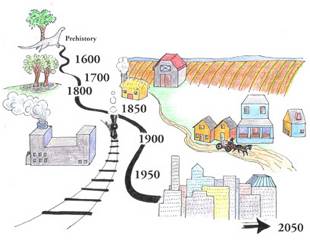
-The Geology and Biology Teams present their findings.
-The class discusses the relationships among biological and geological processes at the study site.
-The Social Science and Ecology Teams present their findings.
-The class discusses the relationship between social processes that have an impact on the study site and the ecological circumstances of their community.
In this activity, the teams present their findings from the Your Study Site in Time investigation. Their assignments emphasized the biological and geological processes that shaped the study site and its surrounding area into what they are today. Since each team was responsible for a different part of the class-wide cooperative investigation, the presentations provide an opportunity for students to exchange information. They are also a good time for students to engage in peer review, since students are relying on one another's work.
This activity involves team presentations of the Your Study Site in Time assignments to the class, followed by a whole class discussion of the teams' findings. You may want to allow a brief question-and-answer period after each presentation. This is an excellent opportunity for students to practice peer review. Depending on the degree of students' experience with reviewing one another, you may want to agree on the system the class will use to respond to one another's presentations and posters.
Students need to have finished their Your Study Site in Time assignments and be ready to make their presentations.
1. Have the Geologists and Biologists present their findings.
Here are some questions students might consider as they listen to the presentations: What were the central findings made by each team? What were the sources of their findings? How many different sources did each team use? Were the sources verified? What new questions arose during the teams' research or from the class as a result of the presentations?
2. With the class, consider the findings and the relationships between geological and biological processes at the study site. Many new questions about the history of the study site may arise during this discussion. You may want to collect these questions in a class notebook (as an idea bank), or have students record them in their GL Journals. Taken together, such questions are one excellent source for Extended Investigations later in the curriculum.
3. Have the Social Scientists and Ecologists present their findings.
4. With the class, consider the connections between social processes and ecological events in the community and at the study site. For example, was the land ever cleared for logging or agriculture? Did the industrial revolution have an impact on the study site? How have local conservation or recycling efforts influenced the study site? How did the advent of sewage systems change the study site's ecology?
5. Ask students what they learned by placing their study site into historical context. Does knowing about the various forces at work on the study site illuminate its future? Have historical contexts provided students with any insights or greater awareness of the site's characteristics today? If so, have students record these reflections in their journals.
Have the student teams, if possible, transform their presentations and posters into Web pages. These pages add wonderful detail to the Web portrait of your study site and community. Though the curriculum dedicates no specific class time to the creation of these pages, they can be assigned as extra credit or as extensions to the Your Study Site in Time investigation itself.